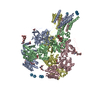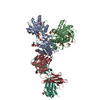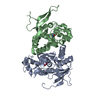+ データを開く
データを開く
- 基本情報
基本情報
| 登録情報 | データベース: PDB / ID: 6mmj | |||||||||
|---|---|---|---|---|---|---|---|---|---|---|
| タイトル | Diheteromeric NMDA receptor GluN1/GluN2A in the 'Super-Splayed' conformation, in complex with glycine and glutamate, in the presence of 1 millimolar zinc chloride, and at pH 7.4 | |||||||||
 要素 要素 |
| |||||||||
 キーワード キーワード | TRANSPORT PROTEIN / Ligand-gated Ion Channel / NMDA Receptor / ionotropic Glutamate Receptors / membrane protein | |||||||||
| 機能・相同性 |  機能・相同性情報 機能・相同性情報neurotransmitter receptor transport, plasma membrane to endosome / regulation of response to alcohol / response to ammonium ion / receptor recycling / directional locomotion / pons maturation / response to environmental enrichment / positive regulation of Schwann cell migration / regulation of cell communication / EPHB-mediated forward signaling ...neurotransmitter receptor transport, plasma membrane to endosome / regulation of response to alcohol / response to ammonium ion / receptor recycling / directional locomotion / pons maturation / response to environmental enrichment / positive regulation of Schwann cell migration / regulation of cell communication / EPHB-mediated forward signaling / auditory behavior / Assembly and cell surface presentation of NMDA receptors / serotonin metabolic process / olfactory learning / conditioned taste aversion / dendritic branch / response to hydrogen sulfide / regulation of respiratory gaseous exchange / response to other organism / positive regulation of inhibitory postsynaptic potential / protein localization to postsynaptic membrane / cellular response to magnesium ion / regulation of ARF protein signal transduction / response to methylmercury / conditioned place preference / locomotion / response to glycine / propylene metabolic process / dendritic spine organization / response to carbohydrate / regulation of NMDA receptor activity / sleep / cellular response to dsRNA / cellular response to lipid / Synaptic adhesion-like molecules / regulation of monoatomic cation transmembrane transport / NMDA glutamate receptor activity / RAF/MAP kinase cascade / voltage-gated monoatomic cation channel activity / response to manganese ion / neurotransmitter receptor complex / transmitter-gated monoatomic ion channel activity / NMDA selective glutamate receptor complex / cellular response to zinc ion / ligand-gated sodium channel activity / response to morphine / calcium ion transmembrane import into cytosol / glutamate receptor signaling pathway / glutamate binding / regulation of axonogenesis / neuromuscular process / male mating behavior / regulation of dendrite morphogenesis / protein heterotetramerization / regulation of synapse assembly / spinal cord development / positive regulation of reactive oxygen species biosynthetic process / glycine binding / parallel fiber to Purkinje cell synapse / positive regulation of calcium ion transport into cytosol / suckling behavior / response to amine / startle response / dopamine metabolic process / social behavior / response to lithium ion / monoatomic cation transmembrane transport / associative learning / modulation of excitatory postsynaptic potential / regulation of neuronal synaptic plasticity / cellular response to glycine / regulation of postsynaptic membrane potential / monoatomic cation transport / excitatory synapse / positive regulation of excitatory postsynaptic potential / response to light stimulus / action potential / positive regulation of protein targeting to membrane / monoatomic ion channel complex / positive regulation of dendritic spine maintenance / Unblocking of NMDA receptors, glutamate binding and activation / long-term memory / cellular response to manganese ion / postsynaptic density, intracellular component / glutamate receptor binding / neuron development / synaptic cleft / prepulse inhibition / multicellular organismal response to stress / phosphatase binding / monoatomic cation channel activity / calcium ion homeostasis / glutamate-gated receptor activity / response to fungicide / presynaptic active zone membrane / cell adhesion molecule binding / regulation of neuron apoptotic process / glutamate-gated calcium ion channel activity / ligand-gated monoatomic ion channel activity involved in regulation of presynaptic membrane potential / dendrite membrane 類似検索 - 分子機能 | |||||||||
| 生物種 |  | |||||||||
| 手法 | 電子顕微鏡法 / 単粒子再構成法 / クライオ電子顕微鏡法 / 解像度: 16.5 Å | |||||||||
 データ登録者 データ登録者 | Jalali-Yazdi, F. / Chowdhury, S. / Yoshioka, C. / Gouaux, E. | |||||||||
| 資金援助 |  米国, 2件 米国, 2件
| |||||||||
 引用 引用 |  ジャーナル: Cell / 年: 2018 ジャーナル: Cell / 年: 2018タイトル: Mechanisms for Zinc and Proton Inhibition of the GluN1/GluN2A NMDA Receptor. 著者: Farzad Jalali-Yazdi / Sandipan Chowdhury / Craig Yoshioka / Eric Gouaux /  要旨: N-methyl-D-aspartate receptors (NMDARs) play essential roles in memory formation, neuronal plasticity, and brain development, with their dysfunction linked to a range of disorders from ischemia to ...N-methyl-D-aspartate receptors (NMDARs) play essential roles in memory formation, neuronal plasticity, and brain development, with their dysfunction linked to a range of disorders from ischemia to schizophrenia. Zinc and pH are physiological allosteric modulators of NMDARs, with GluN2A-containing receptors inhibited by nanomolar concentrations of divalent zinc and by excursions to low pH. Despite the widespread importance of zinc and proton modulation of NMDARs, the molecular mechanism by which these ions modulate receptor activity has proven elusive. Here, we use cryoelectron microscopy to elucidate the structure of the GluN1/GluN2A NMDAR in a large ensemble of conformations under a range of physiologically relevant zinc and proton concentrations. We show how zinc binding to the amino terminal domain elicits structural changes that are transduced though the ligand-binding domain and result in constriction of the ion channel gate. | |||||||||
| 履歴 |
|
- 構造の表示
構造の表示
| ムービー |
 ムービービューア ムービービューア |
|---|---|
| 構造ビューア | 分子:  Molmil Molmil Jmol/JSmol Jmol/JSmol |
- ダウンロードとリンク
ダウンロードとリンク
- ダウンロード
ダウンロード
| PDBx/mmCIF形式 |  6mmj.cif.gz 6mmj.cif.gz | 539.5 KB | 表示 |  PDBx/mmCIF形式 PDBx/mmCIF形式 |
|---|---|---|---|---|
| PDB形式 |  pdb6mmj.ent.gz pdb6mmj.ent.gz | 430.3 KB | 表示 |  PDB形式 PDB形式 |
| PDBx/mmJSON形式 |  6mmj.json.gz 6mmj.json.gz | ツリー表示 |  PDBx/mmJSON形式 PDBx/mmJSON形式 | |
| その他 |  その他のダウンロード その他のダウンロード |
-検証レポート
| 文書・要旨 |  6mmj_validation.pdf.gz 6mmj_validation.pdf.gz | 1.1 MB | 表示 |  wwPDB検証レポート wwPDB検証レポート |
|---|---|---|---|---|
| 文書・詳細版 |  6mmj_full_validation.pdf.gz 6mmj_full_validation.pdf.gz | 1.1 MB | 表示 | |
| XML形式データ |  6mmj_validation.xml.gz 6mmj_validation.xml.gz | 84 KB | 表示 | |
| CIF形式データ |  6mmj_validation.cif.gz 6mmj_validation.cif.gz | 125.1 KB | 表示 | |
| アーカイブディレクトリ |  https://data.pdbj.org/pub/pdb/validation_reports/mm/6mmj https://data.pdbj.org/pub/pdb/validation_reports/mm/6mmj ftp://data.pdbj.org/pub/pdb/validation_reports/mm/6mmj ftp://data.pdbj.org/pub/pdb/validation_reports/mm/6mmj | HTTPS FTP |
-関連構造データ
| 関連構造データ |  9153MC  9147C  9148C  9149C  9150C  9151C  9152C  9154C  9155C  9156C  9157C  9158C  9159C  9160C  9161C  9162C  9163C  9164C  9165C  6mm9C  6mmaC  6mmbC  6mmgC  6mmhC  6mmiC  6mmkC  6mmlC  6mmmC  6mmnC  6mmpC  6mmrC  6mmsC  6mmtC  6mmuC  6mmvC  6mmwC  6mmxC M: このデータのモデリングに利用したマップデータ C: 同じ文献を引用 ( |
|---|---|
| 類似構造データ |
- リンク
リンク
- 集合体
集合体
| 登録構造単位 | 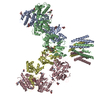
|
|---|---|
| 1 |
|
- 要素
要素
| #1: タンパク質 | 分子量: 94189.781 Da / 分子数: 2 / 断片: UNP residues 1-838 / 由来タイプ: 組換発現 / 由来: (組換発現)   Homo sapiens (ヒト) / 参照: UniProt: P35439 Homo sapiens (ヒト) / 参照: UniProt: P35439#2: タンパク質 | 分子量: 93740.352 Da / 分子数: 2 / 断片: UNP residues 1-837 / 由来タイプ: 組換発現 / 由来: (組換発現)   Homo sapiens (ヒト) / 参照: UniProt: Q00959 Homo sapiens (ヒト) / 参照: UniProt: Q00959#3: 糖 | ChemComp-NAG / Has protein modification | Y | |
|---|
-実験情報
-実験
| 実験 | 手法: 電子顕微鏡法 |
|---|---|
| EM実験 | 試料の集合状態: PARTICLE / 3次元再構成法: 単粒子再構成法 |
- 試料調製
試料調製
| 構成要素 | 名称: Diheteromeric NMDA receptor GluN1/GluN2A in the 'Super-Splayed' conformation, in complex with glycine and glutamate, in the presence of 1 milliomolar zinc chloride, and at pH 7.4 タイプ: COMPLEX 詳細: Sample was heterologously expressed in TSA-201 cells, detergent solubilized, and affinity purified Entity ID: #1-#2 / 由来: RECOMBINANT | |||||||||||||||||||||||||
|---|---|---|---|---|---|---|---|---|---|---|---|---|---|---|---|---|---|---|---|---|---|---|---|---|---|---|
| 分子量 | 値: 0.5 MDa / 実験値: NO | |||||||||||||||||||||||||
| 由来(天然) | 生物種:  | |||||||||||||||||||||||||
| 由来(組換発現) | 生物種:  Homo sapiens (ヒト) / 細胞: TSA-201 Homo sapiens (ヒト) / 細胞: TSA-201 | |||||||||||||||||||||||||
| 緩衝液 | pH: 7.4 | |||||||||||||||||||||||||
| 緩衝液成分 |
| |||||||||||||||||||||||||
| 試料 | 濃度: 4 mg/ml / 包埋: NO / シャドウイング: NO / 染色: NO / 凍結: YES / 詳細: This sample was monodisperse | |||||||||||||||||||||||||
| 試料支持 | グリッドの材料: GOLD / グリッドのサイズ: 300 divisions/in. / グリッドのタイプ: Quantifoil R1.2/1.3 | |||||||||||||||||||||||||
| 急速凍結 | 装置: FEI VITROBOT MARK IV / 凍結剤: ETHANE / 湿度: 100 % / 凍結前の試料温度: 291 K / 詳細: sample was blotted for 3 seconds at blot force 1. |
- 電子顕微鏡撮影
電子顕微鏡撮影
| 実験機器 |  モデル: Titan Krios / 画像提供: FEI Company |
|---|---|
| 顕微鏡 | モデル: FEI TITAN KRIOS |
| 電子銃 | 電子線源:  FIELD EMISSION GUN / 加速電圧: 300 kV / 照射モード: FLOOD BEAM FIELD EMISSION GUN / 加速電圧: 300 kV / 照射モード: FLOOD BEAM |
| 電子レンズ | モード: BRIGHT FIELD / Cs: 2.7 mm |
| 撮影 | 平均露光時間: 22 sec. / 電子線照射量: 52 e/Å2 フィルム・検出器のモデル: GATAN K2 BASE (4k x 4k) 撮影したグリッド数: 2 / 実像数: 1068 |
- 解析
解析
| ソフトウェア | 名称: PHENIX / バージョン: 1.13_2998: / 分類: 精密化 | |||||||||||||||||||||||||||||||||
|---|---|---|---|---|---|---|---|---|---|---|---|---|---|---|---|---|---|---|---|---|---|---|---|---|---|---|---|---|---|---|---|---|---|---|
| EMソフトウェア |
| |||||||||||||||||||||||||||||||||
| CTF補正 | タイプ: PHASE FLIPPING AND AMPLITUDE CORRECTION | |||||||||||||||||||||||||||||||||
| 対称性 | 点対称性: C1 (非対称) | |||||||||||||||||||||||||||||||||
| 3次元再構成 | 解像度: 16.5 Å / 解像度の算出法: FSC 0.143 CUT-OFF / 粒子像の数: 6081 / アルゴリズム: FOURIER SPACE / 対称性のタイプ: POINT | |||||||||||||||||||||||||||||||||
| 原子モデル構築 | プロトコル: RIGID BODY FIT | |||||||||||||||||||||||||||||||||
| 原子モデル構築 | 3D fitting-ID: 1 / Source name: PDB / タイプ: experimental model
|
 ムービー
ムービー コントローラー
コントローラー



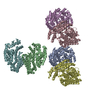
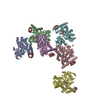
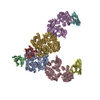
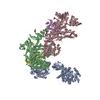

 PDBj
PDBj





